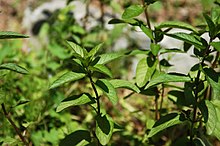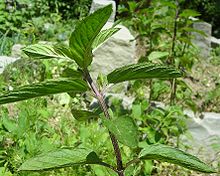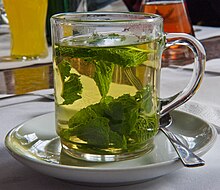peppermint
| peppermint | ||||||||||||
|---|---|---|---|---|---|---|---|---|---|---|---|---|

Peppermint ( Mentha × piperita ) |
||||||||||||
| Systematics | ||||||||||||
|
||||||||||||
| Scientific name | ||||||||||||
| Mentha × piperita | ||||||||||||
| L. |
The peppermint ( Mentha × piperita ) is a medicinal and aromatic plant belonging to the mint genus . It is a - probably coincidentally created - cross of Mentha aquatica and Mentha spicata , whereby Mentha spicata in turn is a cross of Mentha rotundifolia and Mentha longifolia . The main difference between peppermint and other mints is its high menthol and low caravan content and its sharper taste (hence the name “peppermint”).
Peppermint was named Medicinal Plant of the Year 2004.
Spreading and multiplication
There are numerous wild growing species of mint that are native to Europe, see mint . The genus Mentha (mint) is very variable and tends to hybridize ; an exact delimitation of the different cultivars and varieties is difficult.
It was not until 1696 that the biologist John Ray discovered the particularly medicinal peppermint ( Mentha × piperita ) in an English garden as a - probably accidental - cross between brook mint ( Mentha aquatica ) and green mint ( Mentha spicata ). Since Mentha spicata is itself a cross between horse mint ( Mentha longifolia ) and Mentha rotundifolia , peppermint is a largely sterile triple bastard; true propagation is therefore only possible vegetatively (by cuttings), but not from seeds. Breeding efforts have resulted in many subspecies, varieties, and forms. Peppermint was grown in Mitcham near London around 1750; the dark green Mitcham variety is the most valued to this day. A rough distinction is made between dark green ( black mint ) and light green ( white mint ) varieties.
The peppermint always comes from cultures of the temperate climatic zones and often grows wild from the cultures, for example near Mitcham in Surrey / England and in southern Germany. Major cultures can be found in Michigan and New York , Spain, the Balkans, South America, and Asia.
In Germany there are smaller growing areas in the moor areas around Munich, especially in the municipality of Eichenau , where the only peppermint museum is located. In addition, peppermint is cultivated in the fields in Lower and Middle Franconia as well as in Upper and Lower Bavaria and the Upper Palatinate and in the eastern Thuringian Basin . There is a railway line from Straussfurt to Großheringen called the " Pfefferminzbahn " ( Pfefferminzbahn ), since it was set up to transport the herbs harvested in this area - mainly peppermint.
Appearance
The peppermint is a perennial herbaceous plant. The 30 to 90 cm high peppermint is a frost-hardy perennial that has shallow roots and develops numerous sub- and above-ground runners . The stems are slightly to very hairy and not very branched, sometimes with a reddish coating. The leaves are arranged crosswise, opposite to one another, oblong-ovoid to lanceolate, roughly toothed on the edge and often provided with a purple vein. The pink to purple blooming flowers appear from July to September and have terminal spikes. The black and bluish lilac colored flowers, interrupted at the base, are terminal.
The peppermint is a long-day plant. Runners are mainly formed under short-day conditions; under long-day conditions over 14 hours it grows upright and flowers. The herb dies in autumn, and the plant sprouts again in spring. The leaves smell peculiar, slightly balsamic and taste pleasantly spicy, initially warming, then noticeably cooling.
use
The leaves contain peppermint essential oil and are often used as a tea-like drink or spice . The most important ingredient is menthol , which is increasingly found in the older leaves. The first annual harvest takes place shortly before flowering (flowering period June to August) and produces the higher quality; the second harvest in autumn the lesser. Some of the leaves are sold fresh, but mostly dried (peppermint tea). Furthermore, large amounts are required for the extraction of the essential peppermint oil. Peppermint oil is used extensively as a smell and flavor.
Since peppermint has only been known since 1696, it is missing in the herbal books of antiquity and the Middle Ages. However, other mints have been used before.
Medicinal plant
Peppermint is one of the most popular medicinal plants, although the usual food quality usually has an active ingredient content that is far too low for medicinal use. However, a satisfactory effect requires a sufficiently high dosage; therefore pharmacopoeia quality is required (including at least 1.2 percent essential oil, food quality in some cases drastically lower). The most important active ingredient is essential oil, as well as labiate tanning agents, flavonoids and others. Peppermint has a stimulating effect on bile flow and bile juice production, antispasmodic for gastrointestinal complaints, antimicrobial and antiviral. It is therefore used with success in the case of biliary complaints (including mild biliary colic) and "upset stomachs". The essential oil is also used for rubbing in for migraines, headaches and nerve pain, and for inhaling for colds; The same applies to all strongly smelling essential oils: Be careful with babies and small children. In the case of a cold, the subjectively perceived cooling effect is in the foreground, which is perceived as refreshing and pleasant; there is no measurable decongestant effect. Special preparations, which are prepared in such a way that they only dissolve in the intestine, are also used for irritable bowel syndrome. In addition, the active ingredients of peppermint also have a slightly calming effect. Peppermint is therefore also used in teas for calming nerves and promoting sleep.
drink
Non alcoholic
Mint tea is widely used as a soft drink. Fresh or dried leaves of the plant are doused with hot water. The taste is determined by the essential oils and the slightly astringent taste effect of the tannins. Even with long-term use, no harmful effects are to be expected.
Fresh peppermint from the home garden is also used, which often thrives there for years without special care and sometimes grows wild. Often no distinction is made between the different types of mint, which can taste considerably different.
In Arab and North African countries, peppermint tea (mostly heavily sweetened) is a national drink ; but also in Europe it is often drunk as a luxury food.
Alcoholic
Peppermint can be used for the cold prepared mojito and other cocktails . Peppermint essences are used in the preparation of peppermint liqueur .
Sweets
Peppermint is also often used to make peppermint confectionery, peppermint fragments , peppermint talers (coated in chocolate), peppermint candies, peppermint chewing gum or for chocolate fillings and as an ice cream.
Others
In the Upper Bavarian municipality of Eichenau , west of Munich, the “ Peppermint Museum ” is dedicated to the medicinal plants that were cultivated there until the 1950s. In addition to the cultivation, harvest and drying of peppermint, the museum deals with the history, mythology and medicinal properties of the plant.
See also
literature
- Gisela Bernadette Sgoll: From mint to peppermint. A chat about plant history. In: Contributions to the history of pharmacy. Supplement to Deutsche Apotheker-Zeitung 25, 1973, No. 4, pp. 25-28.
Individual evidence
- ↑ Information publication Bayerische Landesanstalt für Landwirtschaft (LfL), Freising, Vöttinger Straße 38, 85354 Freising, 4th revised edition November 2001.
- ↑ Ursel Bühring : Practical textbook of modern medicinal plants. Basics, application, therapy. 2nd, revised edition, Sonntag Verlag, Stuttgart, ISBN 3-8304-9097-6 , p. 278.
Web links
- Mint in the medicinal plants wiki at naturhausmittel.de
- Homepage. Förderverein Pfefferminzmuseum e. V., accessed June 27, 2011 .
- Menthol content against abdominal pain
- Peppermint: active ingredients - application - dosage forms




